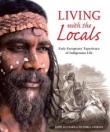AustLit
Latest Issues
AbstractHistoryArchive Description
'Living with the Locals comprises the stories of 13 white men, boys and women who were taken in by the Indigenous people of the Torres Strait islands and of eastern Australia and who lived in their communities between the 1790s and the 1870s, from a few months to over 30 years. The white people had been shipwrecked or had escaped the confines of penal servitude and survived only through the Indigenous people’s generosity. Many of them were given Indigenous names—Bunboé, Murrangurk, Duramboi, Waki, Giom, Anco. They assimilated to varying degrees into an Indigenous way of life—several marrying and learning the language—and, for the most part, both parties mourned the white people’s return to European life.
'The stories in Living with the Locals provide a glimpse into Indigenous life at the point of early contact between Indigenous people and British colonists. It was a time when negative attitudes towards Indigenous people gave rise to misinterpretation of events and sensationalised versions of the stories. However, many of the white survivors spoke up against the appalling treatment of the Indigenous people, and advocated for conciliation and land rights. They also were unwilling to reveal Indigenous beliefs and customs to unsympathetic colonists.' (Publication summary)
Notes
-
Contents:
Chapter 1. John Wilson, Hawkesbury, 1790s - Chapter 2. William Buckley, Port Phillip Bay, 1803-1835 - Chapter 3. Thomas Pamphlett, Richard Parsons & John Finnegan, Moreton Bay, March-September 1823
Chapter 4. James Davis & David Bracefell, Moreton Bay, 1829-1842 & 1831-1842
Chapter 5. John Ireland & William D'Oyley, Mer (Murray Island), Torres Strait, 1834-1836
Chapter 6. Eliza Fraser, Fraser Island, late June-August 1836
Chapter 7. Barbara Thompson, Muralug (Prince of Wales Island), Torres Strait, 1844-1849
Chapter 8. James Morrill, Townsville-Bowen, 1846-1863
Chapter 9. Narcisse Pelletier, Prince Charlotte Bay, 1858-1875.
Publication Details of Only Known VersionEarliest 2 Known Versions of
Works about this Work
-
Locality and Legacy in Indigenous History Now
2017
single work
essay
— Appears in: History Australia , vol. 14 no. 3 2017; (p. 498-502)'Over the past decade there has been a burgeoning interest in compiling material that looks back at early settler-colonial interactions with Indigenous peoples. There has also been an increased interest in historically examining the protest movements that defined Indigenous politics from the 1960s onwards. In visual and performing arts, in novels and poems, in documentary and feature films and in public and academic history, investigations have focused, with more critical lenses, on the localised specificities and cultural legacies of Indigenous experiences. In Living with Locals: Early Europeans’ Experience of Indigenous Life by John Maynard and Victoria Haskins, and A Handful of Sand: The Gurindji Struggle, After the Walk-Off by Charlie Ward, two very different explorations of Indigenous history are presented. One centres on localised examples of early European settlers who lived with Indigenous peoples. The other focuses on the cultural legacy left behind by the Gurindji people’s struggle for economic, political and cultural self-determination. Each, in its own distinct way, is a welcome and refreshing addition to Indigenous historical inquiry. They are both balanced, intriguing and sophisticated, and there is little doubt that they are important contributions to a historical field that is comfortably expanding.' (Introduction)
-
Looking at Our Colonial History from the Indigenous Perspective
2016
single work
single work
essay
review
— Appears in: Torres News , 12-18 December no. 1246 2016; (p. 10)'A new book gives an insight into how Indigenous people across the country perceived and interacted with European shipwreck survivors and convict escapees who they took into their communities.'
-
Book Looks at How Escaped Convicts Lived with 'Locals'
2016
single work
column
— Appears in: Koori Mail , 30 November no. 640 2016; (p. 15)
-
Book Looks at How Escaped Convicts Lived with 'Locals'
2016
single work
column
— Appears in: Koori Mail , 30 November no. 640 2016; (p. 15) -
Looking at Our Colonial History from the Indigenous Perspective
2016
single work
single work
essay
review
— Appears in: Torres News , 12-18 December no. 1246 2016; (p. 10)'A new book gives an insight into how Indigenous people across the country perceived and interacted with European shipwreck survivors and convict escapees who they took into their communities.'
-
Locality and Legacy in Indigenous History Now
2017
single work
essay
— Appears in: History Australia , vol. 14 no. 3 2017; (p. 498-502)'Over the past decade there has been a burgeoning interest in compiling material that looks back at early settler-colonial interactions with Indigenous peoples. There has also been an increased interest in historically examining the protest movements that defined Indigenous politics from the 1960s onwards. In visual and performing arts, in novels and poems, in documentary and feature films and in public and academic history, investigations have focused, with more critical lenses, on the localised specificities and cultural legacies of Indigenous experiences. In Living with Locals: Early Europeans’ Experience of Indigenous Life by John Maynard and Victoria Haskins, and A Handful of Sand: The Gurindji Struggle, After the Walk-Off by Charlie Ward, two very different explorations of Indigenous history are presented. One centres on localised examples of early European settlers who lived with Indigenous peoples. The other focuses on the cultural legacy left behind by the Gurindji people’s struggle for economic, political and cultural self-determination. Each, in its own distinct way, is a welcome and refreshing addition to Indigenous historical inquiry. They are both balanced, intriguing and sophisticated, and there is little doubt that they are important contributions to a historical field that is comfortably expanding.' (Introduction)




